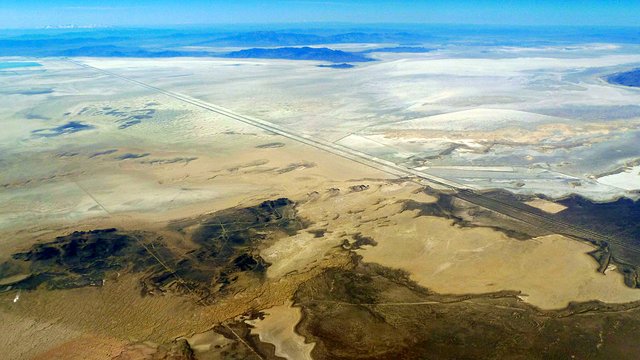The Bonneville Salt Flats are located in the Great Salt Lake Desert west of Salt Lake City. Instead of the usual topography of sand, the salt flats contain salt crystals that can be six feet deep in certain areas. This part of the desert is white and covers 30,000 acres. The ground is flat with occasional mountains. The salt crystals are remnants of Lake Bonneville. When the lake evaporated, the salt stayed.

How the Salt Flats Were Formed
Lake Bonneville was formed at the end of the ice age. As glaciers melted, water spilled into an inland basin located in Utah forming Lake Bonneville. At the time, it was the largest lake in North America extending 20,000 square miles. The lake rested in most of Utah and parts of Idaho and Nevada.
Because of the lake’s location in a basin, there were no outlets for the water to escape. All water from the glacier and rain were captured in this basin. During this time, minerals were collected in the water creating salt crystals. Eventually, the lake broke through its rock barrier and caused a massive flood. After the flood waters receded into the Pacific Ocean, Bonneville Lake had fallen 350 feet. What was left of the lake eventually evaporated, leaving behind many smaller lakes, rivers, and canyons. One of the most interesting landmarks left by the lake are the Bonneville Salt Flats.
Today this land is fully maintained by the U.S. Department of Interior Bureau of Land Management. Their purpose is to protect deterioration of the natural environment. They do this by removing salt that becomes wet during the winter months. They dry out the salt and return it to the salt flats in the spring. To help preserve the minerals, there are no man-made structures except for a few access roads for tourists.
Attractions at the Salt Flats
The Bonneville Salt Flats attract thousands of visitors every year. It is also a popular place to film commercials and movies and for photographers. Because of its flat surface, the most popular use of the Bonneville Salt Flats is land speed racing.
Every summer, racing events are held for professional and amateur drivers who compete for speed records using various motorized vehicles. Several hundreds of records have been recorded during these events which have been taking place since 1914. The most popular races are held during Speed Week every August. Because of its history of racing, the Bonneville Salt Flats are listed on the National Register of Historic Landmarks.
Things You Should Know When Visiting
It is free to visit the salt flats and they are open to visitors most of the year. Land speed events are open to the public, however there is usually a fee to attend. Visitor information can be found on the U.S. Department of the Interior Bureau of Land Management’s website. Below are a few important things to know when visiting.
- Facilities such as food and restrooms are not available at the salt flats except during events.
- During the summer months, it is a good idea to use sunscreen as temperatures can top 100 degrees Fahrenheit.
- When leaving the access road and entering the salt flats, there are no directional signs. It is a good idea to use a GPS to avoid getting lost.
- Upon leaving the access road in a vehicle, stay on the white surface. Traveling on the light brown areas, also known as mud flats, can cause a vehicle to become stuck.
- Do not drive through areas of salt covered in water. Salt water can damage electrical systems in vehicles.
- Traveling the salt flats after dark is not recommended.
- Camping on the salt flats is prohibited.
Sources
-
- Lake Bonneville and the Bonneville Flood. Hugefloods.com.
- The Bonneville Salt flats. Utah.com.
Awesome photo Dude
Downvoting a post can decrease pending rewards and make it less visible. Common reasons:
Submit